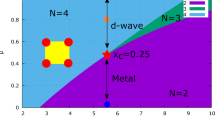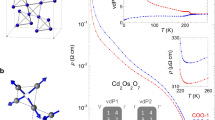Abstract
Because the cuprate superconductors are doped Mott insulators, it would be advantageous to solve even a toy model that exhibits both Mottness and superconductivity. We consider the Hatsugai–Kohmoto model1,2, an exactly solvable system that is a prototypical Mott insulator. Upon either doping or reducing the interaction strength, our exact calculations show that the system becomes a non-Fermi liquid metal with a superconducting instability. In the presence of a weak pairing interaction, the instability produces a thermal transition to a superconducting phase, which is distinct from the traditional state described by Bardeen–Cooper–Schrieffer (BCS) theory, as evidenced by a gap-to-transition temperature ratio exceeding the universal BCS limit. The elementary excitations of this superconductor are not Bogoliubov quasiparticles but rather superpositions of doublons and holons, composite excitations that show that the superconducting ground state of the doped Mott insulator inherits the non-Fermi liquid character of the normal state. An unexpected feature of this model is that it exhibits a superconductivity-induced transfer of spectral weight from high to low energies, as seen in the cuprates3, as well as a suppression of the superfluid density relative to that in BCS theory.
This is a preview of subscription content, access via your institution
Access options
Access Nature and 54 other Nature Portfolio journals
Get Nature+, our best-value online-access subscription
$29.99 / 30 days
cancel any time
Subscribe to this journal
Receive 12 print issues and online access
$209.00 per year
only $17.42 per issue
Buy this article
- Purchase on Springer Link
- Instant access to full article PDF
Prices may be subject to local taxes which are calculated during checkout




Similar content being viewed by others
Data availability
All data that support the plots within this paper and other findings of this study are available from the corresponding author upon reasonable request.
References
Hatsugai, Y. & Kohmoto, M. Exactly solvable model of correlated lattice electrons in any dimensions. J. Phys. Soc. Jpn 61, 2056–2069 (1992).
Baskaran, G. An exactly solvable fermion model: spinons, holons and a non-Fermi liquid phase. Mod. Phys. Lett. B 5, 643–649 (1991).
Molegraaf, H. J. A., Presura, C., van der Marel, D., Kes, P. H. & Li, M. Superconductivity-induced transfer of in-plane spectral weight in Bi2Sr2CaCu2O8 + δ. Science 295, 2239–2241 (2002).
Cooper, L. N. Bound electron pairs in a degenerate Fermi gas. Phys. Rev. 104, 1189–1190 (1956).
Shankar, R. Renormalization-group approach to interacting fermions. Rev. Mod. Phys. 66, 129–192 (1994).
Polchinski, J. Effective field theory and the Fermi surface. Preprint at https://arxiv.org/pdf/hep-th/9210046v2.pdf (1992).
Phillips, P. Colloquium: identifying the propagating charge modes in doped Mott insulators. Rev. Mod. Phys. 82, 1719–1742 (2010).
Dzyaloshinskii, I. Some consequences of the Luttinger theorem: the Luttinger surfaces in non-Fermi liquids and Mott insulators. Phys. Rev. B 68, 085113 (2003).
Meinders, M. B. J., Eskes, H. & Sawatzky, G. A. Spectral-weight transfer: breakdown of low-energy-scale sum rules in correlated systems. Phys. Rev. B 48, 3916–3926 (1993).
Chen, C. T. et al. Electronic states in La2 − xSrxCuO4 + δ probed by soft-X-ray absorption. Phys. Rev. Lett. 66, 104–107 (1991).
Uchida, S. et al. Optical spectra of La2 − xSrxCuO4: effect of carrier doping on the electronic structure of the CuO2 plane. Phys. Rev. B 43, 7942–7954 (1991).
Santander-Syro, A. F. et al. Pairing in cuprates from high-energy electronic states. Europhys. Lett. 62, 568–574 (2003).
Setty, C. Pairing instability on a Luttinger surface: a non-Fermi liquid to superconductor transition and its gravity dual. Phys. Rev. B 101, 184506 (2020).
Božović, I., He, X., Wu, J. & Bollinger, A. T. Dependence of the critical temperature in overdoped copper oxides on superfluid density. Nature 536, 309–311 (2016).
Sachdev, S. & Ye, J. Gapless spin-fluid ground state in a random quantum Heisenberg magnet. Phys. Rev. Lett. 70, 3339–3342 (1993).
Kitaev, A. A Simple Model of Quantum Holography: Part 1. http://online.kitp.ucsb.edu/online/entangled15/kitaev/ (2015).
Dave, K. B., Phillips, P. W. & Kane, C. L. Absence of Luttinger’s theorem due to zeros in the single-particle Green function. Phys. Rev. Lett. 110, 090403 (2013).
Muthukumar, V. N. & Baskaran, G. A toy model of interlayer pair hopping. Mod. Phys. Lett. B 08, 699–706 (1994).
Metlitski, M. A., Mross, D. F., Sachdev, S. & Senthil, T. Cooper pairing in non-Fermi liquids. Phys. Rev. B 91, 115111 (2015).
Varlamov, A. A., Galda, A. & Glatz, A. Fluctuation spectroscopy: from Rayleigh–Jeans waves to Abrikosov vortex clusters. Rev. Mod. Phys. 90, 015009 (2018).
Patel, A. A., Lawler, M. J. & Kim, E.-A. Coherent superconductivity with a large gap ratio from incoherent metals. Phys. Rev. Lett. 121, 187001 (2018).
Cai, W. & Ge, X.-H. Superconducting gap ratio in a SYK-like model. Preprint at https://arxiv.org/pdf/1809.01846.pdf (2018).
Wang, Y. Solvable strong-coupling quantum-dot model with a non-Fermi-liquid pairing transition. Phys. Rev. Lett. 124, 017002 (2020).
Esterlis, I. & Schmalian, J. Cooper pairing of incoherent electrons: an electron–phonon version of the Sachdev–Ye–Kitaev model. Phys. Rev. B 100, 115132 (2019).
Chowdhury, D. & Berg, E. Intrinsic superconducting instabilities of a solvable model for an incoherent metal. Phys. Rev. Res. 2, 013301 (2020).
Wu, Y.-M., Abanov, A., Wang, Y. & Chubukov, A. V. Special role of the first Matsubara frequency for superconductivity near a quantum critical point: nonlinear gap equation below Tc and spectral properties in real frequencies. Phys. Rev. B 99, 144512 (2019).
Yang, S.-L. et al. Revealing the Coulomb interaction strength in a cuprate superconductor. Phys. Rev. B 96, 245112 (2017).
Zaanen, J. Planckian dissipation, minimal viscosity and the transport in cuprate strange metals. SciPost Phys. 6, 061 (2019).
Zaanen, J., Liu, Y., Sun, Y. & Schalm, K. Holographic Duality in Condensed Matter Physics (Cambridge Univ. Press, 2015).
Paramekanti, A., Trivedi, N. & Randeria, M. Upper bounds on the superfluid stiffness of disordered systems. Phys. Rev. B 57, 11639–11647 (1998).
Acknowledgements
We thank C. Setty for extensive discussions on his work that ultimately motivated the search for an exactly solvable model with Mottness and superconductivity, G. La Nave for a critical analysis of the results, and C. Boyd for many helpful discussions. P.W.P. acknowledges DMR19-19143 for partial funding of this project and E.W.H. was supported by the Gordon and Betty Moore Foundation EPiQS Initiative through grant no. GBMF 4305.
Author information
Authors and Affiliations
Contributions
P.W.P. initiated the problem and computed the pair instability. L.Y. computed the susceptibility with the numerics on the binding energy and E.W.H. computed the wave function, elementary excitations and the superfluid density.
Corresponding author
Ethics declarations
Competing interests
The authors declare no competing interests.
Additional information
Peer review information Nature Physics thanks Jan Zaanen and the other, anonymous, reviewer(s) for their contribution to the peer review of this work.
Publisher’s note Springer Nature remains neutral with regard to jurisdictional claims in published maps and institutional affiliations.
Supplementary information
Rights and permissions
About this article
Cite this article
Phillips, P.W., Yeo, L. & Huang, E.W. Exact theory for superconductivity in a doped Mott insulator. Nat. Phys. 16, 1175–1180 (2020). https://doi.org/10.1038/s41567-020-0988-4
Received:
Accepted:
Published:
Issue Date:
DOI: https://doi.org/10.1038/s41567-020-0988-4
This article is cited by
-
1/4 is the new 1/2 when topology is intertwined with Mottness
Nature Communications (2023)
-
Unconventional exciton evolution from the pseudogap to superconducting phases in cuprates
Nature Communications (2022)
-
Discrete symmetry breaking defines the Mott quartic fixed point
Nature Physics (2022)
-
High-temperature superconductivity
Nature Reviews Physics (2021)
-
Carriers that count
Nature Physics (2020)



